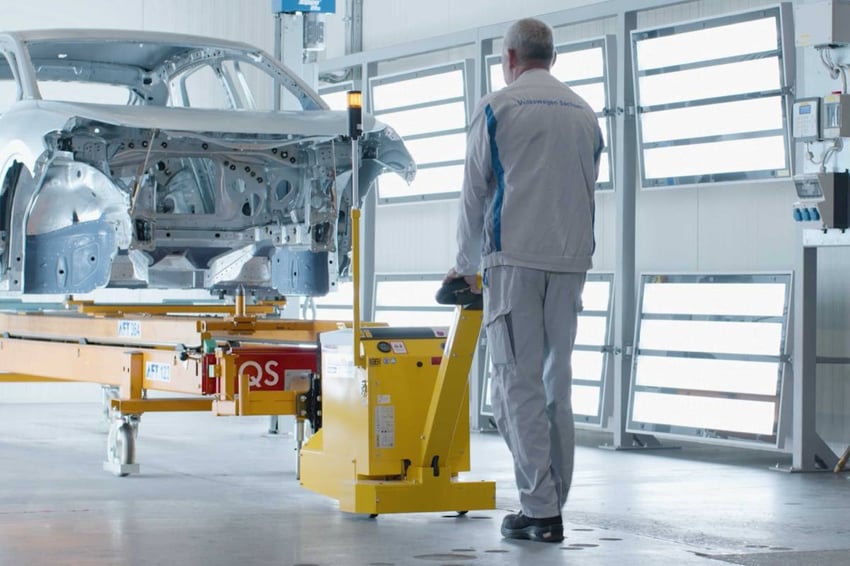Material Handling Market Set For Major Growth

A market that is undergoing a period of significant growth and transformation is that of material handling. But what exactly is material handling? It encompasses the machinery and tools used to move and store goods during manufacturing, warehousing, and distribution.
From electric tugs and forklifts to cranes and automated guided vehicles (AGVs), this equipment plays a crucial role in optimising operational efficiency across various industries.
The global material handling market is projected to increase to $407.8 billion (USD) by 2033 — from $229.9 billion in 2023 — representing a compound annual growth rate (CAGR) of 5.9%. This growth is driven by a variety of factors, from the rise of ecommerce to technological advancements.

Key market growth drivers
Ecommerce
Several factors are contributing to the robust growth of the material handling equipment market. The surge in ecommerce is a major driver, resulting in increased demand for efficient warehouse solutions and equipment.
Online retail expansion requires advanced handling systems within warehouses and distribution centres to manage and dispatch a growing volume of orders. The adoption of sophisticated material handling systems is driven by a need within order fulfilment for speed, accuracy, and reliability. Reflected in the market analysis, we can see that ecommerce dominates the application segment with a 22.6% share.
Automation
In addition, technological advancements in automation and robotics are boosting efficiency and cutting operational costs. Manufacturing, retail, and distribution businesses are looking to automate their operations to reduce labour costs and improve product management accuracy.
Automated Guided Vehicles or AGVs are increasingly being used to automate towing processes, making them popular for the automotive industry and logistics businesses because of the repetitive nature of how products are moved from A to B, yet their applications extend to any industry where towing tractors are currently being used to move loads inside and outside.
There are many different types of AGV available, each designed for different tasks. For example, towing AGVs are designed to pull trolleys or carts in a train formation, making them ideal for environments where loads need to be moved over long distances with multiple drop-off and pick-up points. Alternatively, unit load or mouse AGVs are used to transport individual items such as engines or powertrains in heavy plant assembly and are ideal for bridging production stages between conveyors.

This push towards automation in manufacturing industries and logistics is also boosting the adoption of material handling systems that are equipped with AI (artificial intelligence) and IoT (internet of things). It's estimated that by 2025 over 4 million warehouse robots will be installed worldwide in more than 50,000 warehouses.
The adoption of robotics and artificial intelligence (AI) will also be a continuing trend, as more companies start to use these technologies for automating processes and improving efficiency. The integration of real-time data and IoT allows for continuous monitoring of equipment, enabling predictive maintenance and reducing downtime. Cloud-based warehouse management systems (WMS) also offer centralised control and real-time visibility of inventory and material flow.
Logistics infrastructure
Growing investments in smart factories and logistics infrastructure, particularly in emerging economies, are supporting market expansion. Governments worldwide are increasingly investing in logistics and trade infrastructure to support economic growth, including funding for smart warehouses and automation-friendly facilities.
For instance, China, India, and the U.S. are leading efforts in modernising supply chains through strategic investments in technology. Global trade in goods and services is expected to increase by $350 billion in the first half of 2024, which will increase the need for material handling solutions.
These global infrastructure improvements are fueling a surge in demand for advanced material handling equipment. From fast-paced distribution centres to sprawling warehouses, businesses need efficient solutions to keep goods moving. This translates to a growing market for versatile equipment that can handle diverse loads and adapt to changing layouts, such as electric tugs and AGVs, maximising space and resources. With a naturally compact design and pin-point precision, tugs are adaptable and provide instant operational improvements, offering a more flexible way to move wheeled loads.
Challenges and opportunities
Despite this projected growth, the material handling equipment market will be facing several challenges:
- High initial costs, particularly for automated systems, create barriers for many businesses.
- Lack of a skilled workforce to operate and maintain advanced equipment also restricts market growth.
- Limited adoption among small and medium-sized enterprises (SMEs) and fluctuating raw material prices pose potential challenges.
However, numerous opportunities exist for growth. Emerging markets in Asia, Africa, and Latin America are investing heavily in logistics, warehousing, and manufacturing, creating a strong need for material handling solutions globally.
With an increasing push for sustainable and eco-friendly equipment globally, electric handling solutions are taking the spotlight as many companies are looking to opt for alternatives to traditional equipment with internal combustion engines (ICE).
Electric tugs and AGVs offer significant productivity and ROI benefits as well as being fully electric which reduces emissions and noise levels for businesses. Many electric tug solutions also provide unmatched flexibility and precision, particularly in confined spaces or when needing to move complex and heavy loads, compared to traditional handling equipment.

The path forward
While the market is seeing a rise in all kinds of material handling solutions, the most innovative and efficient solutions are centering around automation, using vehicles that are flexible and easy to integrate into existing workflows.
The material handling equipment market is set for continued growth, driven by the increasing demand for efficiency, automation, and sustainability. Companies that embrace these trends, invest in technology, and adapt to changing market demands will be well-positioned for success.
As businesses look to optimise their supply chains, the need for advanced and reliable material handling solutions will only continue to increase, highlighting the importance for innovation and industry expertise in a material handling equipment provider for any business navigating this dynamic market.